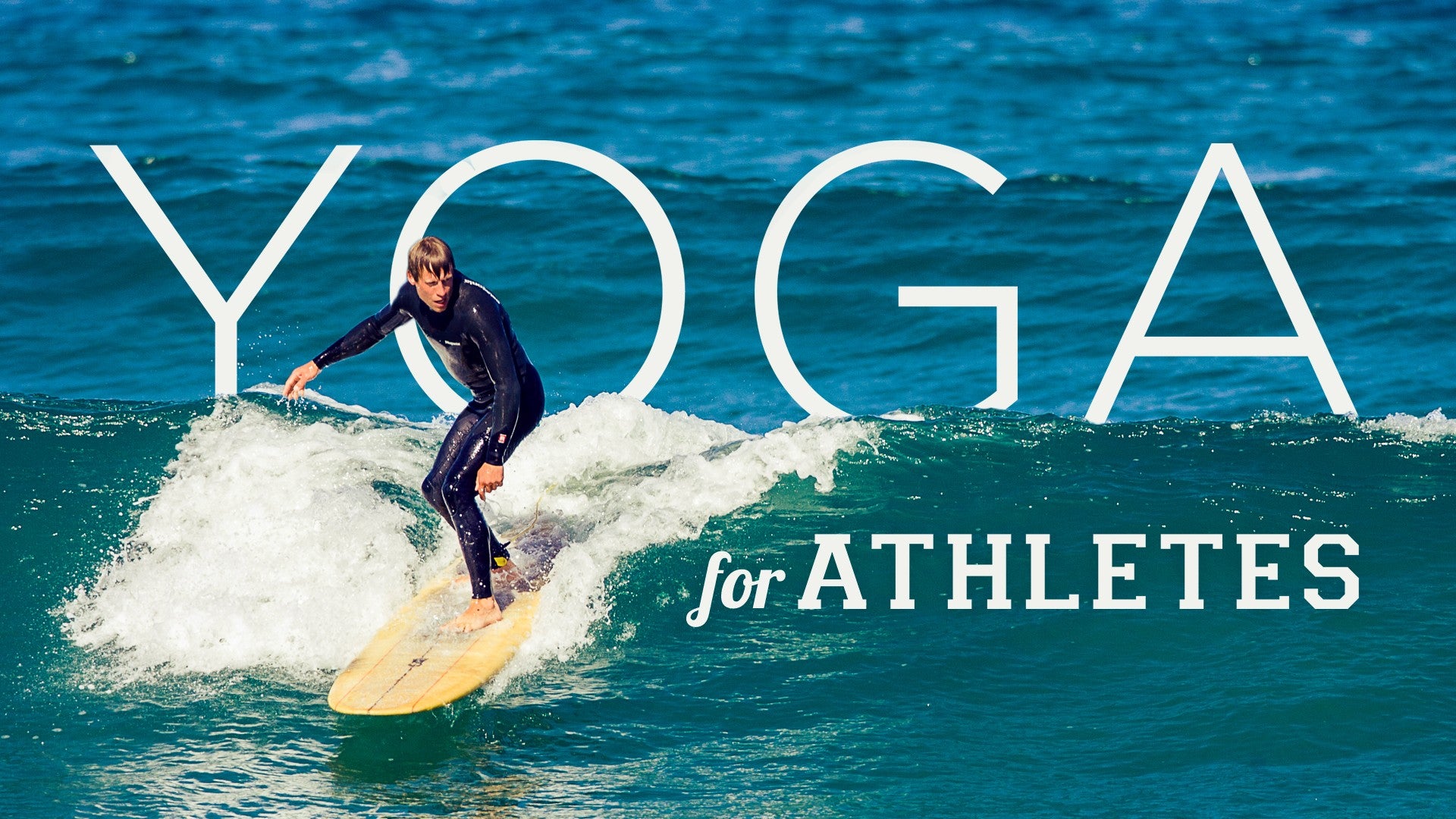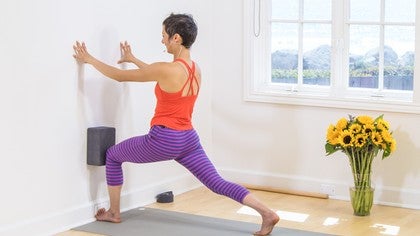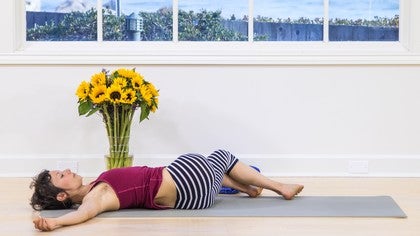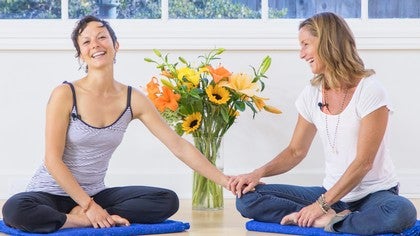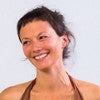Description
While this sequence was created with runners in mind, it will benefit most. A wooden dowel is suggested, but not required.
About This Video
Transcript
Read Full Transcript
(waves crashing) Hi, this is a short yoga for runners, and we're gonna look at getting into the hamstrings with a leg stretch sequence, getting into the feet for the plantar fascia, obviously a lot of stress goes into the feet and calves and the hip flexors. And I think I said this already that big on strengthening the outer glutes, the abductor muscles, which can prevent the hip sway that is really inefficient in running and also many people with iliotibial band syndrome have really weak outer glutes. So a lot of these sequences are recuperative more, and this one, we'll just work on a little bit of strengthening for that area. I have to make a shout out to my friend, Scott Drift for outlining a few key points that went into the sequence. So thank you, Scott.
For this sequence, it will be useful for you potentially to have a strap. It's okay if you don't have one. A block and any sort of stick-like structure that's even and smooth that resembles this wooden dowling. If you have a wooden dowel, great. They're pretty easy to get, just a couple of bucks or something at the hardware store.
But you could also use a broom or a vacuum cleaner extension. You could be creative. It's worth getting one. This is what we're gonna use to get into the feet. So let's place this down.
Come on up to standing and place your feet on the prop just below the knuckles under your toes and walk down towards the middle of the arch and then keep walking down towards heel and you can come all the way to just in front of the heel. And we're just gonna walk back and forth and massage this area. So for some people, this is super intense. If it is that for you, you can take one foot back and sort of lean your weight and control how much weight that you like to drop, pour into this leg. I like to shift side to side and just go up and down.
I use this a ton with people. It's amazing to open up the plantar fascia of the feet. And interesting point, if you open up the plantar fascia of your feet, your forward fold is actually deeper because that fascia is a continuous chain that goes all the way up the back of the leg into the lumbar, up the back, and actually comes right into the space in between your eyebrows. So somebody, workers have found, you can do something like this, you can also roll on a ball and then you forward fold and you've got like two more inches crazy. Anyways, I'll keep this brief because you might not have one of this, but I'm gonna show you one more thing to get into the calves.
So if you come down and you had something like this, you take your legs, hip distance apart, and snuggle the prop on top of the belly of the calf and right at the back of the hamstring and then sit back on this and try to relax in the amount of sensation that you're getting here in the back of the hamstring and the back of the calf. So this is a really nice deep pressure, and then you can come up whenever you're ready and move it down a little bit, maybe right into the belly of the calf and sit back down. You could also actually roll up your yoga mat. Not the entire thing maybe, but just half of its roll, put that there and leave the rest of the mat behind you, if you know what I mean, and it'd be a little less sensational, little less pressure than something wooden but you'd probably still feel it quite a bit. And so then we can move down a little bit.
And then for most people, you could actually come up as long as kneeling the front of your ankles is okay. And then I'll press my hands down on the sides and just lean side to side. And I'm kind of on the top of the Achilles right now and this is a wonderful way, this deep pressure, to get into the Achilles. The Achilles is a really hard place to stretch or to loosen because it's so... It's really so much connective tissue.
So it's very sticky and plastic in nature. So longer holds deep pressure. And then maybe you'd go down and do a little bit more, like anywhere along the Achilles that you want. So I could hang here for a while but just in case you don't have this prop, let's move on. So let's just take a child's pose, extending my hands forwards.
Let the head come down, press the fingers down, find your breath. I just read something that Kenyan people or runners actually have longer Achilles tendons and more elastic calf muscles that make them generally better runners. Interesting. (chuckles) Tuck your toes, reach back into downward facing dog, pedal out your feet and then hopefully, you've set your mat up so there's a wall behind you. If not, move your mat so that there's a wall behind you.
Tuck your toes under and see if your stubborn pinky toe can get under there and take one foot forwards into a lunge. Come up onto your fingertips and align your heels so that it's over your second toes. So it's not moving in. It's over the second toe. And then let's hang here for a couple of breaths.
Can you soften your left hip? Can you press a nice long line through your right leg? And breath. Think about the femur bone here moving up into the hip socket instead of sinking down. Actually moving up.
So if you tend to slump forwards, this is another thing with runners, is see if you can maintain a plumb line. So like a line through your ears through your shoulders and all the way down into your heel, which will make you more efficient in your movement, hopefully. So soften your back knee and come up. We're gonna take a few breaths here, getting right into the business right away. So bend down into your right knee a little bit and bend down enough that you feel like your pelvis is not tipping forward.
So it's actually coming into a place where it's perpendicular to the floor. You might even put your hands on your hips and rotate it backwards a bit. And then once you establish that, start to pour some more straightening into your back leg and see if you can get a nice long line here and five deep breaths. Sometimes I think like a deeper sounding breath accompanied by a strong stretch is nice. So you can deepen the sound of your breath.
If it feels okay, you can lift your arms up. And runners look down a ton, so if you can take your gaze forwards and find that plumb line, so maybe it even means that the skull comes back a little bit, the back of the neck elongates and you find that ear, shoulder, hip here plumb line. Whoo. (giggles) So extend especially through the inner heel. One more breath.
And exhale, come down into your dog pose and just walk out your legs. Just to get a little bit more into the calves here, bend your right leg, really root your left heel into the floor and shift forwards into a plank pose and really press back through your left heel so you can not hyperextend the leg but open up the back of the knee. And come back and just switch sides. Pressing back through the heel as you move forwards through the head. And exhale.
Come on back, walk a little closer to the wall, tuck all your toes under, even the pinky toe. Make sure the heel is not rolling into the midline so it moves back. Step your right foot forwards, come into a lunge. Feel like the left femur bone sucks up a bit. Actually, to soften the front of the hips.
Find your plumb line. And another key factor in the plumb line is to set the shoulder blades on the back instead of hunching them forwards or collapsing them forwards. Press a long line through your inner heel. Then firm through the legs, pleasantly stiff through the legs here. Come up.
Bend your back knee, align your pelvis. So It's not tip forwards. And there's a neutrality in your lower back muscles as you do this, so the back muscles stay quiet. And then once you feel that, start to pour some straightening into your back leg and press through the inner heel. And then find the plumb line.
You can find the position of your skull might move slightly back. If the chest is popped forwards, it might move slightly back and elongate the arms. It's kind of hard to be bored in a position like this. Pretty engaging, a couple more breaths. Get a little bit longer.
Find the heels beaming away from the Achilles tendons, elongating. Exhale, downward dog. Pedal out the feet, walk your hands back towards your feet. Soften your knees, forward fold. You can interlock opposite elbows, hold onto the outer calves or ragdoll your arms.
And take your time to roll all the way up to standing. And we're gonna turn around and do the same lunge against the wall this way. I wanna show it to you with a block. So you can tuck the toes under, and this is just nice to open up the bottom of the feet. And just because I don't want my knee to move too far over the ankle line, I'm gonna place something there, which is gonna prevent it from doing that, which will put strain on the knee joint a little bit.
So I like this. If you don't have it, it's fine. You just watch that. Wiggle back until you're in that bent knee lunge. A little bit of the posterior rotation of the pelvis so the back muscles are neutral.
And with these outer glutes, just think about squeezing them into the center. So there's a strength so the bones stay in the skin instead of sort of hanging out in your joints. Press your fingers into the wall and connect your arms into your core. Pressing into your fingers, move the belly away from the wall and find your plumb line. You can also start to straighten that back leg and take five breaths.
I'm checking in also with the position of my sitting bones. One might come a little higher than the other and I want to drop down through that sit bone to feel like there's not really that much tone in my lower back muscles here, there's a softness there, a lot of energy in the legs. One more breath. And we're gonna let the block go from there, walk out your legs. Take your elbows to the wall, interlock your fingers, let your forehead come to the wall and try not to bend too much in your lower back but inflate your lower back with your breath and drop your chest to the wall.
You could also be a little closer. Let's switch sides. So toes, block. Depending on how big your feet are too, you might switch the block so it's more like that. I have super small feet so that works for me.
And then wiggle yourself back into the lunge, bend your back knee, find the pelvis, coming into more of a perpendicular place, feeling the sit bones, the squeeze of the outer hips and then find your plumb line. And connect your arms into your core because as you press, your belly will hug back towards your spine. Three more breaths. You can't tell but this is actually making me sweat a little bit. (laughs) You can also feel maybe that the lower points of your shoulder blades are moving down your back.
And let's exhale out of this one. If you're using a wooden block, you wanna be careful it doesn't drop on your toes when you come out of that. To the wall, inflate your lower back, let your upper back relax. And let's turn around and come to the front of the mat. We'll do a little gentle flow.
Feet together at the top of the mat. Okay, reconnect with your breathing. Look forwards. Find an evenness of tone through your whole body so that you're not gripping somewhere more than another part. And inhale your arms up.
Exhale, soften your knees, fold forwards. Inhale, lengthen forwards, shift your weight into your left foot, suck your right foot up into your body. So right leg comes up into the body. Your pelvis will be a little asymmetrical. Now without moving your left hip out to the side, hug the left outer hip muscles into the body, take your right leg straight out the side, abducting the leg, A-B ducting, and then bring it back in.
And again, so not much movement in your back, your torso. There's a hugging in of the outer muscles of the hips into the body. Tendency is to kind of sway out to the sides. So connect in through that outer hip. And you might gradually start to bring the leg a little bit higher out to the side.
Then we're gonna swing that leg behind so that you're kind of in a crisscross position. Soften your knees, inhale, lengthen your lower belly and exhale and fold, pressing your big toes into the floor. Inhale, come up a little bit. Exhale, sweep that leg back into the high lunge and step back into downward facing dog. From downward facing dog, round your way into cobra pose, connect the bottom tips of your shoulder blades down, elbows in, come all the way down.
And now we're gonna widen our knees a little bit, bend our knees, take the big toes together and we're gonna think about taking your lower belly off of the mat. So press your pubic bone down and lift your lower belly off of the mat. It might not come off the mat, but think about doing that. Chin forwards or forehead down. Using your outer glutes, arms can be wherever you want.
Start to lift your legs a little bit and lower them, maintaining a feeling of your belly sucking back towards your spine and actually not using your back muscles so much. So I like to put my hands there, lifting up and lowering to see if there's kind of a neutral feeling in the lower back. This is not easy. So just a couple more. Outer glutes are working and you're also getting into those hip flexors a little bit.
And exhale and release. Tops of the feet to the floor, hands forwards. Inhale, bring the back bend into your upper chest. Squeeze your elbows together and exhale, downward dog. Pedal out your feet.
Breath. Bend your knees, step or hop your feet towards the top of the mat. Inhale, exhale, fold. Inhale, come all the way up. Exhale, other side.
Inhale, the arms up. Exhale, fold. Shift into the right, keep that outer hips strong. Suck the left hip up into the body. So your left hip is higher than your right.
And then start to take it out to the side a few times without shifting over to the right. So there's a squeezing and a hugging in. Sorry sunflowers, (laughs) taking this leg out to the side. One more time. And then relax that leg, take it back behind you.
Crisscross your little softness in the knees. Relax and lengthen your lower belly and exhale and fold. You could also be up here if that's just way too intense for you to come down low like that. Or hand on a block. See with each breath if you can actually release and lengthen your lower belly to find that you're not stressing or shortening your lower back.
And then let that leg come back into the high lunge, exhale, downward dog. Inhale forwards. Exhale to the belly. So on the belly, you can even take your fists here and place them on the inside of your frontal hipbone. So this is where the psoas muscle is deep, deep in there, behind a few layers of tissue, and that for me is a really interesting release.
And it also makes the lower back much more long. So it might be too intense for you to keep your hands there, but if it's possible, pubic bone down, knees a little wide, feet together; using the outer glutes, just lift and lower the legs. And I'm kind of coming up in my chest here, which is fine. You can take your forehead down or your chin down. Is it possible for you to relax the back of your pelvis, like not squeeze your bum cheeks together but just use the strength of the outer glutes and move them down towards your knees?
So one more. Exhale release. Really nice belly massage. Inhale, come into the cobra. Upper back bend.
Exhale, downward dog. Bend your knees, step or hop towards top of the mat. Inhale, exhale, fold. Inhale, come up. Exhale.
Let's do one more time each side. Inhale, come up. Exhale, fold. Inhale, suck right leg up. Exhale out to the side.
Inhale, exhale. Inhale, exhale. Inhale, exhale it back. Bend the knees a bit. Inhale, lengthen the belly.
Exhale, fold. Press into your big toes. Inhale, high lunge, downward dog. Pedal out your feet. Stretch out the calf flesh.
Inhale, roll forwards. Exhale to the belly. This time, knees wide, big toes together, all those actions. Inhale, lift. Exhale, lower.
Inhale, lift. Exhale, lower. Inhale, lift. Exhale, lower. It's not how high you get but how much can you keep your back out of it using the outer glutes.
Exhale, inhale, move the emphasis point of the back bend into the upper back. Exhale back. Bend your knees, step or hop forward. Inhale, exhale. Other side, inhale, come up.
Exhale, all the way back down. Inhale, suck the leg up, exhale out to the side. Inhale, exhale, hugging in through the outer hips. Inhale, exhale. Inhale, exhale.
Last one. Without locking the knees, inhale, lengthen the belly, crisscross the legs. Exhale, fold. Continue to lengthen the belly. It's almost like there's a wave movement in your spine with every breath.
Step back, high lunge, downward dog. Inhale, exhale. Knees wide, feet together. You can check out your lower back if you want to, pubic bone down. Inhale, exhale.
You can also have your forehead down, inhale, exhale. Two, three, four, one more. Five, release down and enjoy the feeling of moving the back bend into your upper chest. Tailbone down, exhale, downward dog. From downward dog, child's pose.
We're gonna come onto the back here to do some leg stretches. So sink back on your heels. Hmm, so take a breath here and roll up and come onto your back. And if you have a strap, then it may be useful here. So we're gonna come down, straighten out the left leg.
Try to stay in the center of the heel, draw the right knee in, hug it in. And extend that leg upwards. So you can either hold behind the back of the leg. You can hold the back of the calf, you can hold the foot or if you're far from reaching that, grab a strap, like this. And I actually like wrapping the strap around the hands a couple times so that I'm not pulling, so that I can just hang the weight of my arms here.
And it might feel good to move into a little bit of oscillation, hydration of the back of the leg. Sliding those muscle fibers a bit. And let's take a couple of breaths. I wanna add I'm not gonna stay in these for too long, but the Yin Series for Athletes, you may wanna check those out because we'll do a little bit longer holds in some of these postures. So a few breaths and then we're gonna take the strap into the right hand, we have the right leg, and let that leg come out to the side without uprooting your left pelvis.
So taking out the side. What I actually like to do here is sometimes just release it, hold the outer leg, because I don't really love this position of holding on to the strap. So you can play around with it. So a couple of breaths, don't uproot this pelvis. Drop it down.
So there's a little bit of core strengthening here as well, Opening up the inner leg. Inhale the leg into the center. You can take the strap or not, and we're gonna roll over onto the, do a little roll over to the outside of the left hip. So my outer left foot is on the floor now. I could either use the strap here because I'm going into a twist, or I can release the strap and just kind of make a little kickstand and hold my leg.
Also, if your leg doesn't go straight here, have a little bend in it and slowly start to find your edge, opening up. Of course, if it's there, you can come down to the floor with this leg but not at the expense of gripping in the right hip joint. So compressing that right hip joint to really feel like it's lifting away. Let's come all the way back into the center, take both of your legs up here and draw them in towards you. This is Supta Paschimottanasana.
You can slide up towards your calves. Try to ground the back of your pelvis and draw the legs in towards you. And then, just for fun and to be permissive, roll the back of your pelvis up and draw the legs in towards you more and see the difference in mobility. And then roll back down, drop the right leg, stay on the center of the heel, squish the left leg in. Little bit of activity in the feet.
Lengthen out this leg. I'll show with the strap. Check in to see if the two sides of your lower back are neutral, are relaxed. So quiet back, active legs. You might floss a little bit to the back of the leg here because being in this position might not be your favorite.
But if there's a lot of sensation, sometimes it's easier to be present, and sometimes it's easy to check out when there's too much sensations. So just finding an edge where your curious and interested but you don't have to jump ship. So taking it out to the side, either using the strap or the kickstand without uprooting your right hip ground. Relax your chest. Enjoy the feeling of being in plumb line here, and your back muscles are relaxed.
It's a really nice way to get into the hips. Inhale through the center, do this little hip movement so you're on the outer edge of the foot. Switch hands with the strap, bend the knee, maybe moving into these sliding movements a little bit. You can use the kickstand here as well and try to bring your upper back to the floor to complete the twist. So nice.
Come all the way up. Center your hips and just widen your inner legs for a couple of moments. Take a couple breaths there. Bend your knees and circle your knees like eggbeater style. One way and then the other.
Beautiful, I may have now got to all your spots. If you wanna pause the video here and play a little bit more with your own stuff, that will be a great idea. But now we're gonna go into a relaxation. So since you spend so much time on your feet, we're going to put our legs up the wall. So to do that, come close to the wall kind of in a fetal position on your side.
Extend your arm, roll over onto your back, let your legs come up. So you're on your mat. If you have a block, you can drive your heels into the wall, pick up your hips, and place that block underneath your hips and almost get a feeling of having a little back bend in the upper chest. So the shoulders are kind of looping under you. So this is an option.
If this doesn't feel right for you, just take your relaxation on your back or any way that is really calling you. This is the greatest restorative posture. So it enlivens you if you are feeling flat, and it energizes you, it calmly energizes you. And also, it can calm you completely, soften you, relax you if you're feeling a little bit jacked up in your nervous system. So you can roll your head side to side, close your eyes and relax your legs.
Relax your feet, the soles of your feet, the calves, the knee joints and allow the big muscles of the thighs to feel like they're sort of just sliding off the bones. Draining your legs. Check in with your mind body, observing it without assumption. Just attend to yourself for a few more minutes, allowing yourself to feel free. So you might stay here for quite a bit longer, which I would recommend, or you can slide your knees down towards you, maybe press at your feet into the wall to pick up the weight of your hips off the block if you have it there and slide it over to the side.
And take your time to come up to seated position. Thanks for practicing. Hope to see you soon.
Yoga for Athletes: Preparation Practices
Comments
Lydia
You need to be a subscriber to post a comment.
Please Log In or Create an Account to start your free trial.
